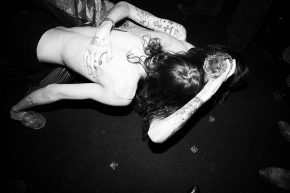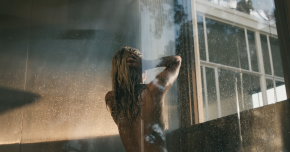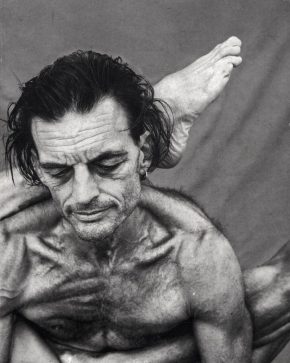

Berlin-based filmmaker Erick Schmidt’s oeuvre comprises a range of haunting films shot on digital or 16 mm, each an elaborate production, and a series of oil paintings. If his earlier films, including Hunting Grounds (2006), Bogged Down (2010) and Gatecrasher (2010), display the leisure life of a privileged European elite, featuring galloping horses and glamorous dinner parties, his latest video work documents a stranger’s observation of a foreign culture.


Schmidt’s video Cut/Uncut, which he filmed towards the end of his time in Japan in 2015, features the protagonist — who as in Schmidt’s earlier films is the artist himself — taking part in everyday life in Tokyo. He walks through the city, eats, drinks and plays on slot machines, and yet does not merge with the society around him. Rooted in Western culture his gaze remains a stranger’s gaze. Towards the middle of the video, the protagonist cuts his suit in a kind of self-invented ceremony in a Japanese teahouse, violently and precisely ripping it to shreds while it is still on his body.

Using ties and belts, he finally transforms the suit into a Japanese seeming robe. By undergoing this self-realised ritualistic experience, which is as physical as it is metaphorical, the artist creates an individual, narrative, visual language to describe Japan, which allows him to experience Japanese culture as closely as a stranger possibly can. With this video, Schmidt nods to traditional Japanese art, samurai films and even Yoko Ono’s Cut Piece, which also relates to the title of the video.

Erick Schmidt’s series of paintings Rays around you, which are also inspired by the time he spent in Japan, depicts intersections – the woven mess of wires and metal – which can be seen as pictorial abstractions of the megapolis of Tokyo and it’s daily life. It is as well a reflection about the technologically enhanced reality of today, with Japan at the forefront of innovation. But in Schmidt’s paintings the technological reality loses its sharpness and clarity and is converted into a colourful abstraction that is dissolved while still physically palpable. The grey, clean geometric structures become colourful, enhanced abstractions.

Schmidt’s work also reveals his interest in the tradition of Japanese art, particularly in the usage of lines. We see lines everywhere: colourful lines running up the walls and wires and lines filling out windows and street signs. Even people whom he portrays deeply engaged with their phones, with their gaze sucked down into the tiny screens, are captured with thick strokes and their faces only outlined.

The title Rays around you suggests both the visible lines of the physical wires and cables one sees when gazing upwards at the intersections on the streets of Tokyo, and also the invisible rays – radio waves, networks, internet connections and radiation waves (think: Fukushima) – that encompass us.


A few of Schmidt’s paintings bear the titles Shiori bq and Yuito bq, which comprise Japanese forenames, coupled with the abbreviation for the unit Becquerel, which once again references radioactivity and radiation. If we think of a name as being an intrinsic part of one’s identity, Schmidt’s titular addition of bq to these paintings could suggest the invisible but pervasive presence of radioactive rays, surrounding each and every individual on the streets of Tokyo.



Words by Veronika Dorosheva.


























Comments